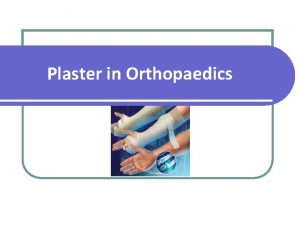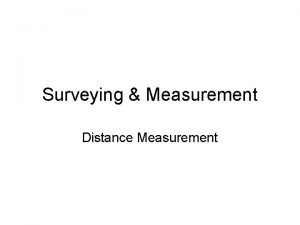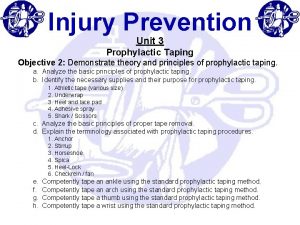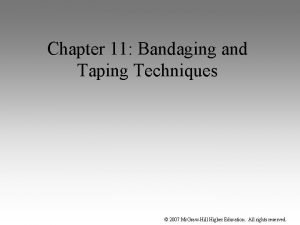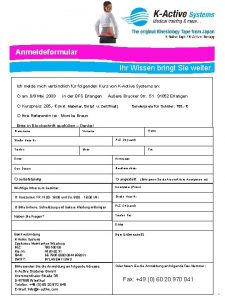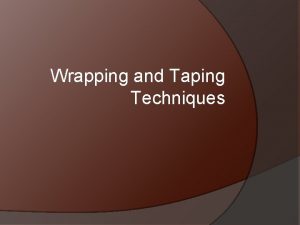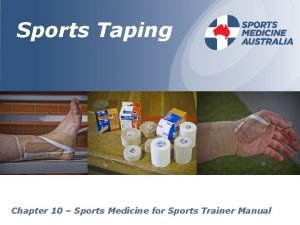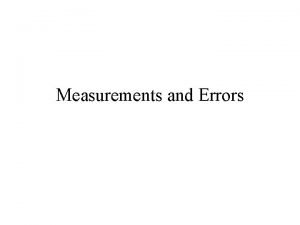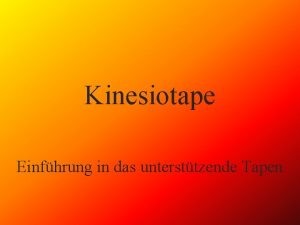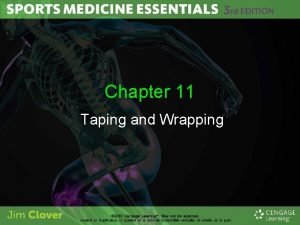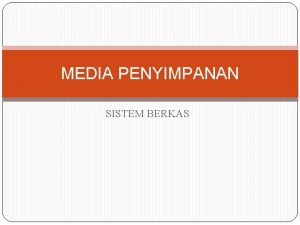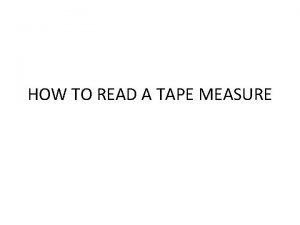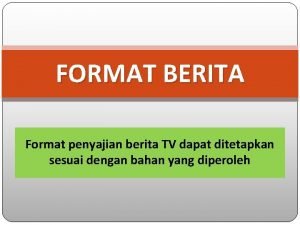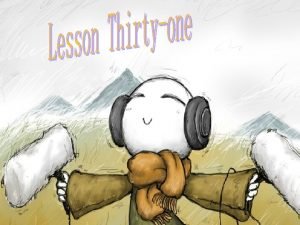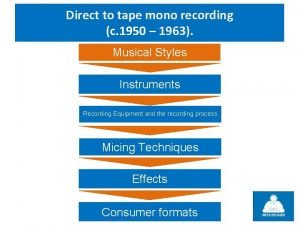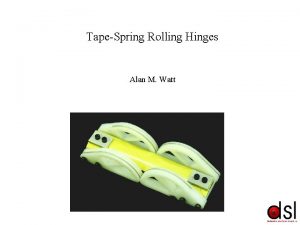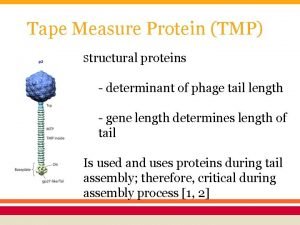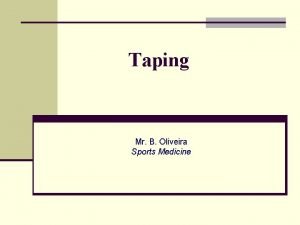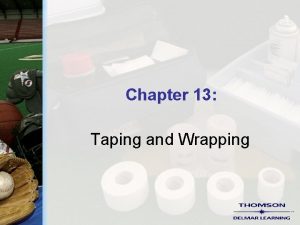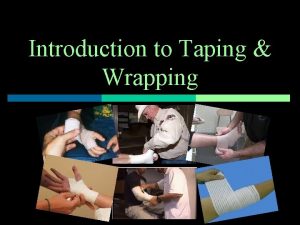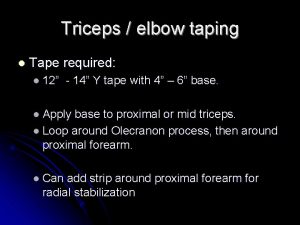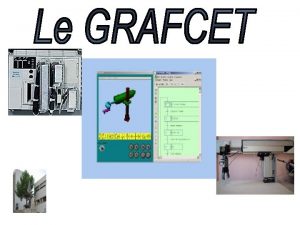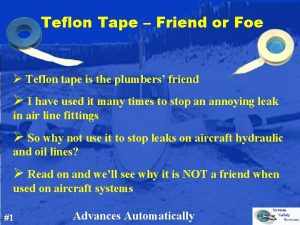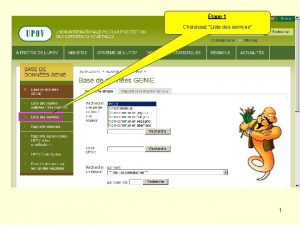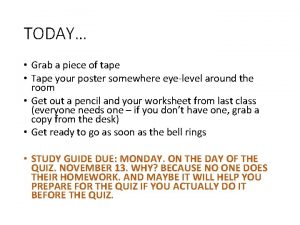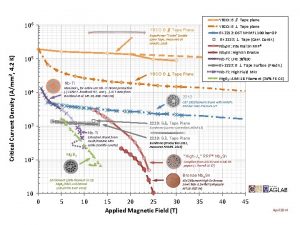Taping Principles of Taping The application of tape


































































































- Slides: 98

Taping

Principles of Taping “The application of tape is an art, and, in the hands of the inexperienced it may be very difficult. Practice is essential to good taping. Neatness is the trademark of a good taper. Be neat, and the respect of the athlete will be earned…. The beginner should start slowly; the application of tape should be very deliberate and neat. After much practice and speed, efficiency will be the result. ” - Stephen Rice, MD

Selection considerations • • Diagnosis of injury Goals of taping Resource available Sport & position Athletes acceptance Research findings Personal preference

Diagnosis of injury • Location • Nature • Severity

Selection considerations • • Diagnosis of injury Goals of taping Resource available Sport & position Athletes acceptance Research findings Personal preference

Goals of taping • Prophylactic • Rehabilitative • Functional

Selection considerations • • Diagnosis of injury Goals of taping Resource available Sport & position Athletes acceptance Research findings Personal preference

Resource available • Human resource • Financial resource

Selection considerations • • Diagnosis of injury Goals of taping Resource available Sport & position Athletes acceptance Research findings Personal preference

Sport and position • A taping that is effective for an athlete in one sport may not be suitable for another athlete • A taping that is effective for an athlete in one sport may not be suitable in another sport • Requirements, Equipment, Environment & Rules

Selection considerations • • Diagnosis of injury Goals of taping Resource available Sport & position Athletes acceptance Research findings Personal preference

Athlete’s acceptance • If the athlete feels that taping is uncomfortable or decreases performance the attempt to support will failed

Selection considerations • • Diagnosis of injury Goals of taping Resource available Sport & position Athletes acceptance Research findings Personal preference

Research findings • With respect to new techniques or products, it is probably best to keep an open mind but to be critical

Selection considerations • • Diagnosis of injury Goals of taping Resource available Sport & position Athletes acceptance Research findings Personal preference

Personal preference • After gaining clinical experience with various taping techniques, one usually begins to have with relying on experience when the athlete is looking for expert answers, as long as each case is viewed individually.

TAPING MECHANISMS: • MECHANICAL • PROPRIOCEPTIVE (DIRECT REFLEX STIMULATION– LEARING PROCESS )

Re-establishing Neuromuscular Control, Proprioception, Kinesthesia and Joint Position Sense • Following injury, body forgets how to integrate information coming in from multiple biological sources • Neuromuscular control is mind’s attempt to teach the body conscious control of a specific movement • Re-establishing neuromuscular control requires repetition of same movement, step by step until it becomes automatic (progression from simple to difficult task • Closed kinetic chain (CKC) exercises are essential for re-establishing control but can be difficult

• Must regain established sensory pattern • CNS constantly compares intent and production of specific movement w/ stored information, constantly modifying until discrepancy in movement is corrected • Four key elements – – Proprioception and kinesthetic awareness Dynamic stability Preparatory and reactive muscle characteristics Conscious and unconscious functional and motor patterns • Must relearn normal functional movement and timing after injury - may require several months • Critical throughout rehab - most critical early in process to avoid reinjury

• Reestablishing proprioception and kinesthesia should be of primary concern – Proprioception is joint position sense (determine position of joint in space) – Kinesthesia is the ability to detect movement • Kinesthesia and proprioception are mediated by mechanoreceptors in muscle and joints, cutaneous, visual, and vestibular input • Neuromuscular control relies on CNS to integrate all areas to produce coordinated movement

• Joint Mechanoreceptors – Found in ligaments, capsules, menisci, labra, and fat pads • Ruffini’s endings • Pacinian corpuscles • Free nerve endings – Sensitive to changes in shape of structure and rate/direction of movement – Most active at end of ranges of motion • Muscle Mechanoreceptors – Muscle spindles - sensitive to changes in length of muscle – Golgi tendon organs - sensitive to changes in tissue tension

Regaining Balance • Involves complex integration of muscular forces, neurological sensory information from mechanoreceptors and biomechanical information • Entails positioning center of gravity (Co. G) w/in the base of support • If Co. G extends beyond this base, the limits of stability have been exceeded and a corrective step or stumble will be necessary to prevent • Even when “motionless” body is constantly undergoing constant postural sway w/ reflexive muscle contractions which correct and maintain dynamic equilibrium in an upright posture

• When balanced is challenged the response is reflexive and automatic • The primary mechanism for controlling balance occurs in the joints of the lower extremity • The ability to balance and maintain it is critical for athletes • If an athlete lacks balance or postural stability following injury, they may also lack proprioceptive and kinesthetic information or muscular strength which may limit their ability to generate an adequate response to disequilibrium • A rehabilitation plan must incorporate functional activities that incorporate balance and proprioceptive training

Principle of taping • Tape selection • Skin care • Application

Tape selection • Size • Type • Quality

Principle of taping • Tape selection • Skin care • Application

Skin care • Skin surface should be clean of oil, perspiration and dirt • Hair should be removed to prevent skin irritation with tape removal • Tape adherent is optional • Foam and skin lubricant should be used to minimize blisters

Principle of taping • Tape selection • Skin care • Application

Rules for Tape Application • Tape in the position in which joint must be stabilized • Overlap the tape by half • Avoid continuous taping • Keep tape roll in hand whenever possible • Smooth and mold tape as it is laid down on skin • Allow tape to follow contours of the skin

Rules for Tape Application (cont. ) • Start taping with an anchor piece and finish by applying a locking strip • Where maximum support is desired, tape directly to the skin • Do not apply tape if skin is hot or cold from treatments

Type of tape • Elastic • Non- Elastic

Uses of elastic taping • To compress & support soft tissue • To provide anchors around muscle thus allowing for expansion • To hold protective pads in place

Uses of non-elastic taping • • • To support inert structures To limit joint movement To protect against re-injury To secure ends of elastic tape To reinforce elastic tape To enhance proprioception

Materials • • Bandaging materials Padding Underlying bandages Fixation bandages Elastic bandages Adhesive bandages Additional materials

Classification • • According to time of application According to type of bandage According to bandaging technique According to bandage materials

Time of application • • First bandage Second bandage Later bandage Prophylactic bandage

Type of bandage • • Open wound Compression bandage Immobilizing bandage Supportive bandage

Bandaging technique • • Circular bandage (dolabra asc. or desc. ) Testudo rev. or inv. Spica asc. or desc. Head bandage (mitra rev. or inv. )

Bandaging material • • Elastic bandage Adhesive bandage cloth tape Self-sticking bandage

Materials • Gauze- sterile pads for wounds, hold dressings in place (roller bandage) or padding for prevention of blisters • Cotton cloth- ankle wraps, triangular and cravat bandages • Elastic bandages- extensible and very useful with sports; active bandages allowing for movement; can provide support and compression for wound healing • Cohesive elastic bandage- exerts constant even pressure; 2 layer bandage that is self adhering;

Elastic Bandages • Gauze, cotton cloth, elastic wrapping • Length and width vary and are used according to body part and size • Sizes ranges 2, 3, 4, 6 inch width and 6 or 10 yard lengths • Should be stored rolled • Bandage selected should be free from wrinkles, seams and imperfections that could cause irritation

Elastic Bandage Application • Hold bandage in preferred hand with loose end extending from bottom of roll • Back surface of loose end should lay on skin surface • Pressure and tension should be standardized • Anchor are created by overlapping wrap – Start anchor at smallest circumference of limb

• Body part should be wrapped in position of maximum contraction • More turns with moderate tension vs. fewer turns with maximum tension • Each turn should overlap by half to prevent separation • Circulation should be monitored when limbs are wrapped

Elastic bandages can be used to provide support for a variety scenarios: • • • Ankle and foot spica Spiral bandage (spica) Groin support Shoulder spica Elbow figure-eight Gauze hand wrist figure-eight • Cloth ankle wrap

Triangle and Cravat Bandages • Cotton cloth that can be substituted if roller bandages not available • First aid device, due to ease and speed of application • Primarily used for arm slings – Cervical arm sling – Shoulder arm sling – Sling and swathe

Cervical Arm Sling • Designed to support forearm, wrist and hand injuries • Bandage placed around neck and under bent arm to be supported

Shoulder Arm Sling • Forearm support when a shoulder girdle injury exists • Also used when cervical sling is irritating

Sling and Swathe • Combination utilized to stabilize arm • Used in instances of shoulder dislocations and fractures

Non-elastic White Tape • Great adaptability due to: – Uniform adhesive mass – Adhering qualities – Lightness – Relative strength • Help to hold dressings and provide support and protection to injured areas • Come in varied sizes (1”, 1 1/2” , 2”) • When purchasing the following should be considered:

• Tape Grade – Graded according to longitudinal and vertical fibers per inch – More costly (heavier) contains 85 horizontal and 65 vertical fibers • Adhesive Mass – Should adhere regularly and maintain adhesion with perspiration – Contain few skin irritants – Be easily removable without leaving adhesive residue and removing superficial skin

• Winding Tension – Critically important – If applied for protection tension must be even

Elastic Adhesive Tape • Used in combination with non-elastic tape • Good for small, angular parts due to elasticity. • Comes in a variety of widths (1”, 2”, 3”, 4”)

Preparation for Taping • Skin surface should be clean of oil, perspiration and dirt • Hair should be removed to prevent skin irritation with tape removal • Tape adherent is optional • Foam and skin lubricant should be used to minimize blisters

• Tape directly to skin • Prewrap (roll of thin foam) can be used to protect skin in cases where tape is used daily • Prewrap should only be applied one layer thick when taping and should be anchored proximally and distally

• Proper taping technique – Tape width used dependent on area – Acute angles = narrower tape • Tearing tape – Various techniques can be used but should always allow athlete to hold on to roll of tape – Do not bend, twist or wrinkle tape – Tearing should result in straight edge with no loose strands – Some tapes may require cutting agents


Taping Guidelines • • Place joint in position to be stabilized Overlap tape ½ width Avoid continuous taping Keep roll in hands at all times Smooth and mold time with free hand Do not force tape Start with an anchor and end with a lock strip Do not tape after a cold / hot modality treatment

Rules for Tape Application • Tape in the position in which joint must be stabilized • Overlap the tape by half • Avoid continuous taping • Keep tape roll in hand whenever possible • Smooth and mold tape as it is laid down on skin • Allow tape to follow contours of the skin

Rules for Tape Application (cont. ) • Start taping with an anchor piece and finish by applying a locking strip • Where maximum support is desired, tape directly to the skin • Do not apply tape if skin is hot or cold from treatments

Taping, Bandaging and Splinting Techniques • Wrist / Hand / Finger – Wrist hyperextension / flexion taping • Fan or spica – Finger buddy taping – Thumb hyperextension / abduction taping • Fan or spica • Elbow – Hyperextension taping • Fan or spica

Taping, Bandaging and Splinting Techniques • Lower Leg – Achilles • Fan or spica • Ankle – Closed gibney basketweave – Open gibney basketweave • Foot / Toes – Arch • “X” • Teardrop • Spread / Fan – Turf toe • Fan

Additional Taping Information • Removing adhesive tape – Removable by hand • Always pull tape in direct line with body (one hand pulls tape while other hand presses skin in opposite direction – Aid of tape scissors and cutters may be required • Be sure not to aggravate injured area with cutting device – Also removable with chemical solvents

Taping Supplies • • Razor (hair removal) Soap (skin cleaning) Alcohol (oil removal) Adhesive spray Prewrap material Heel and lace pads White non-elastic tape • Elastic adhesive tape • Felt and foam padding material • Tape scissors • Tape cutters • Elastic bandages

Common Foot Taping Procedures

Arch Technique 1 (to strengthen weakened arches)

Arch Technique 2 (for longitudinal arch)

Arch Technique 3 (X teardrop arch and forefoot support)

Arch Technique 4 (fan arch support)

Low. Dye Technique (Management of fallen arch, pronation, arch strains and plantar fascitis) (

Sprained Toes

Bunions

Turf Toe (prevents excessive hyperextension of metatarsophalangeal joint)

Hammer or Clawed Toes

Fractured Toes

Common Ankle Taping Procedures

Routine Non-Injury Taping

• Routine Non-injury taping • Closed Basket Weave – Used for newly sprained or chronically weak ankles • Open Basket Weave – Allows more dorsiflexion and plantar flexion, provides medial and lateral stability and room for swelling – Used in acute sprain situations in conjunction with elastic bandage and cold application

Closed Basket weave (Gibney) Technique

Open Basket Weave

Continuous-Stretch Tape Technique

Common Leg & Knee Taping Procedures

Achilles Tendon (prevent Achilles over-stretching)

Collateral Ligament

Rotary Taping for Knee Instability

Knee Hyperextension (Prevent knee hyperextension, provide support to injured hamstring or slackened cruciate ligament)

Patellofemoral Taping (Mc. Connell technique) • Helps to manage glide, tilt, rotation and anteroposterior orientation of patella • Accomplished by passively taping patella into biomechanically correct position • Also provides prolonged stretch to softtissue structures associated with dysfunction

Patellofemoral Taping (Mc. Connell technique)

Patellofemoral Taping (Mc. Connell technique)

Patellofemoral Taping (Mc. Connell technique)

Patellofemoral Taping (Mc. Connell technique)

Patellofemoral Taping (Mc. Connell technique)

Common Upper Extremity Taping Procedures

Elbow Restriction (Prevents elbow hyperextension)

Wrist Technique 1 (Mild wrist sprains and strains)

Wrist Technique 2 (Protects and stabilizes badly injured wrist)

Bruised Hand

Sprained Thumb (Provide support to musculature and joint)

Finger and Thumb Checkreins
 Invar tape
Invar tape Hình ảnh bộ gõ cơ thể búng tay
Hình ảnh bộ gõ cơ thể búng tay Lp html
Lp html Bổ thể
Bổ thể Tỉ lệ cơ thể trẻ em
Tỉ lệ cơ thể trẻ em Gấu đi như thế nào
Gấu đi như thế nào Glasgow thang điểm
Glasgow thang điểm Bài hát chúa yêu trần thế alleluia
Bài hát chúa yêu trần thế alleluia Các môn thể thao bắt đầu bằng từ đua
Các môn thể thao bắt đầu bằng từ đua Thế nào là hệ số cao nhất
Thế nào là hệ số cao nhất Các châu lục và đại dương trên thế giới
Các châu lục và đại dương trên thế giới Công của trọng lực
Công của trọng lực Trời xanh đây là của chúng ta thể thơ
Trời xanh đây là của chúng ta thể thơ Mật thư tọa độ 5x5
Mật thư tọa độ 5x5 Làm thế nào để 102-1=99
Làm thế nào để 102-1=99 độ dài liên kết
độ dài liên kết Các châu lục và đại dương trên thế giới
Các châu lục và đại dương trên thế giới Thể thơ truyền thống
Thể thơ truyền thống Quá trình desamine hóa có thể tạo ra
Quá trình desamine hóa có thể tạo ra Một số thể thơ truyền thống
Một số thể thơ truyền thống Cái miệng nó xinh thế chỉ nói điều hay thôi
Cái miệng nó xinh thế chỉ nói điều hay thôi Vẽ hình chiếu vuông góc của vật thể sau
Vẽ hình chiếu vuông góc của vật thể sau Nguyên nhân của sự mỏi cơ sinh 8
Nguyên nhân của sự mỏi cơ sinh 8 đặc điểm cơ thể của người tối cổ
đặc điểm cơ thể của người tối cổ Giọng cùng tên là
Giọng cùng tên là Vẽ hình chiếu đứng bằng cạnh của vật thể
Vẽ hình chiếu đứng bằng cạnh của vật thể Fecboak
Fecboak Thẻ vin
Thẻ vin đại từ thay thế
đại từ thay thế điện thế nghỉ
điện thế nghỉ Tư thế ngồi viết
Tư thế ngồi viết Diễn thế sinh thái là
Diễn thế sinh thái là Dạng đột biến một nhiễm là
Dạng đột biến một nhiễm là Số nguyên tố là số gì
Số nguyên tố là số gì Tư thế ngồi viết
Tư thế ngồi viết Lời thề hippocrates
Lời thề hippocrates Thiếu nhi thế giới liên hoan
Thiếu nhi thế giới liên hoan ưu thế lai là gì
ưu thế lai là gì Hổ đẻ mỗi lứa mấy con
Hổ đẻ mỗi lứa mấy con Khi nào hổ con có thể sống độc lập
Khi nào hổ con có thể sống độc lập Sơ đồ cơ thể người
Sơ đồ cơ thể người Từ ngữ thể hiện lòng nhân hậu
Từ ngữ thể hiện lòng nhân hậu Thế nào là mạng điện lắp đặt kiểu nổi
Thế nào là mạng điện lắp đặt kiểu nổi Ultrasonic inspection machine
Ultrasonic inspection machine Cast slab splint
Cast slab splint Errors in surveying
Errors in surveying K tape elbow hyperextension
K tape elbow hyperextension Wrist taping athletic training
Wrist taping athletic training Taping surveying
Taping surveying Catenary taping
Catenary taping Prophylactic taping finger
Prophylactic taping finger Basket weave ankle taping
Basket weave ankle taping How to wrap a wrist with ace bandage
How to wrap a wrist with ace bandage Metatarsophalangeal joint
Metatarsophalangeal joint Nominal length meaning in surveying
Nominal length meaning in surveying Itb origin and insertion
Itb origin and insertion Chevron iv taping
Chevron iv taping Taping techniques to prevent knee hyperextension
Taping techniques to prevent knee hyperextension Explosionsschutz fortbildungskurs
Explosionsschutz fortbildungskurs Contact sports
Contact sports Kinesio pronunciation
Kinesio pronunciation Sports medicine taping techniques
Sports medicine taping techniques Taping definition
Taping definition Taping wadenmuskulatur
Taping wadenmuskulatur Elbow hyperextension taping
Elbow hyperextension taping Taping over uneven and sloping ground
Taping over uneven and sloping ground Slatters kne
Slatters kne Prophylactic taping finger
Prophylactic taping finger Scotch tape x ray
Scotch tape x ray Vestige adhesive tape for foot patch
Vestige adhesive tape for foot patch Materials needed in making
Materials needed in making Top bottom
Top bottom Sticky tape lab chemistry answers
Sticky tape lab chemistry answers Smoke detector use
Smoke detector use Pals dosing chart
Pals dosing chart Jenis jenis magnetic tape
Jenis jenis magnetic tape Mark e miller sex tape
Mark e miller sex tape Hymenolepis nana diagnosis
Hymenolepis nana diagnosis Learning to read a tape measure
Learning to read a tape measure News intro template
News intro template Emma watson tape
Emma watson tape Youtube.com
Youtube.com A system has 12 magnetic tape drives and 3 processes
A system has 12 magnetic tape drives and 3 processes Tape based backup
Tape based backup Sewing measuring tape target
Sewing measuring tape target Describe the broselow tape and broselow color code chart
Describe the broselow tape and broselow color code chart Contoh magnetik tape
Contoh magnetik tape Teaching aids conclusion
Teaching aids conclusion Tape diagram example
Tape diagram example Using tape diagrams to solve ratio problems
Using tape diagrams to solve ratio problems Making math magic
Making math magic Tape diagram ratio
Tape diagram ratio Seorang pedagang membeli setengah lusin tas seharga 210
Seorang pedagang membeli setengah lusin tas seharga 210 Chemistry unit 6 sticky tape post lab
Chemistry unit 6 sticky tape post lab 1928 magnetic tape
1928 magnetic tape Play dead
Play dead Tape measure protein
Tape measure protein Sticky tape lab conclusion
Sticky tape lab conclusion Is magnetic tape a secondary storage device
Is magnetic tape a secondary storage device












































